
Browse an alphabetical list of film clips that feature important events before, during, and after the Holocaust and World War II. These clips include home movies, propaganda films, newsreels, and more.
<< Previous | Displaying results 21-30 of 191 for "Film" | Next >>
Benito Mussolini, leader of the Italian Fascist movement, was prime minister of Italy from 1922 until he was dismissed in July 1943. After the Italian armistice with the Allies in September 1943, German forces occupied northern Italy and installed Mussolini as head of a new pro-German government. In April 1945, as Allied forces advanced into northern Italy, Mussolini attempted to escape to neutral Switzerland. However, Italian partisans caught and executed him before he could reach the border. This footage…

As Allied forces approached Germany in late 1944 and early 1945, Bergen-Belsen became a collection camp for tens of thousands of prisoners evacuated from camps near the front. Thousands of these prisoners died due to overcrowding, poor sanitary conditions, and lack of adequate food and shelter. On April 15, 1945, British soldiers entered Bergen-Belsen. They found about 55,000 prisoners in the camp, most in a critical condition. This footage shows Allied cameramen filming the condition of the prisoners and…

In Berlin, Germany, officials from Nazi Germany, Fascist Italy, and Imperial Japan sign the ten-year Tripartite Pact (the Three-Power Agreement), a military alliance. The pact sealed cooperation among the three nations (Axis powers) in waging World War II. This footage comes from "The Nazi Plan," a film produced and used by the United States in the prosecution at the Nuremberg trials.
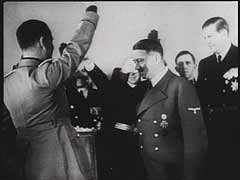
Exterior of house of study. Book peddler negotiates a sale with a young customer.
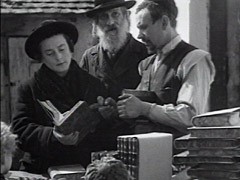
In their drive to rid the country of all that they deemed "un-German," the Nazis publically burned books in cities across Germany. Here in front of the Opera House in Berlin, a chanting crowd burns books written by Jews and leftist intellectuals. Joseph Goebbels, Hitler's minister of propaganda and public information, speaks of the intended "reeducation" of Germany.
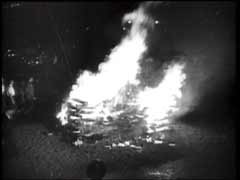
British troops liberated the Bergen-Belsen concentration camp in Germany in April 1945. They filmed statements from members of their own forces. In this British military footage, British army chaplain T.J. Stretch recounts his impressions of the camp.
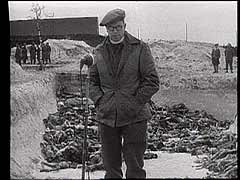
British Chief Prosecutor Sir Hartley Shawcross makes a final plea to the International Military Tribunal.
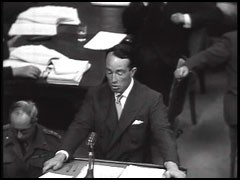
In July 1947 in France, 4,500 Jewish refugees from displaced persons camps in Germany boarded the "Exodus 1947" and attempted to sail (without permission to land) to Palestine, which was under British mandate. The British intercepted the ship off the coast and forced it to anchor in Haifa, where British soldiers removed the Jewish refugees. After British authorities failed to force France to accept the refugees, the refugees were returned to DP camps in Germany. The plight of the "Exodus" passengers became…
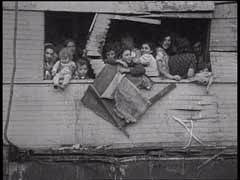
Clip from George Stevens' "The Nazi Concentration Camps." This German film footage was compiled as evidence and used by the prosecution at the Nuremberg trials.
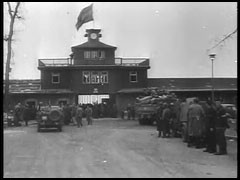
After the Germans established the Warsaw ghetto in October 1940, conditions deteriorated rapidly. The Germans strictly controlled the movement of goods into and out of the ghetto. There was not enough food to feed the ghetto residents. At great personal risk, many Jews attempted to smuggle in food. The German food ration for Warsaw ghetto inhabitants amounted to less than 10 percent of the ration for a German citizen. Thousands of Jew died in Warsaw each month because of starvation or disease.
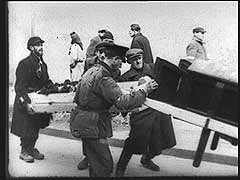
We would like to thank Crown Family Philanthropies, Abe and Ida Cooper Foundation, the Claims Conference, EVZ, and BMF for supporting the ongoing work to create content and resources for the Holocaust Encyclopedia. View the list of donor acknowledgement.